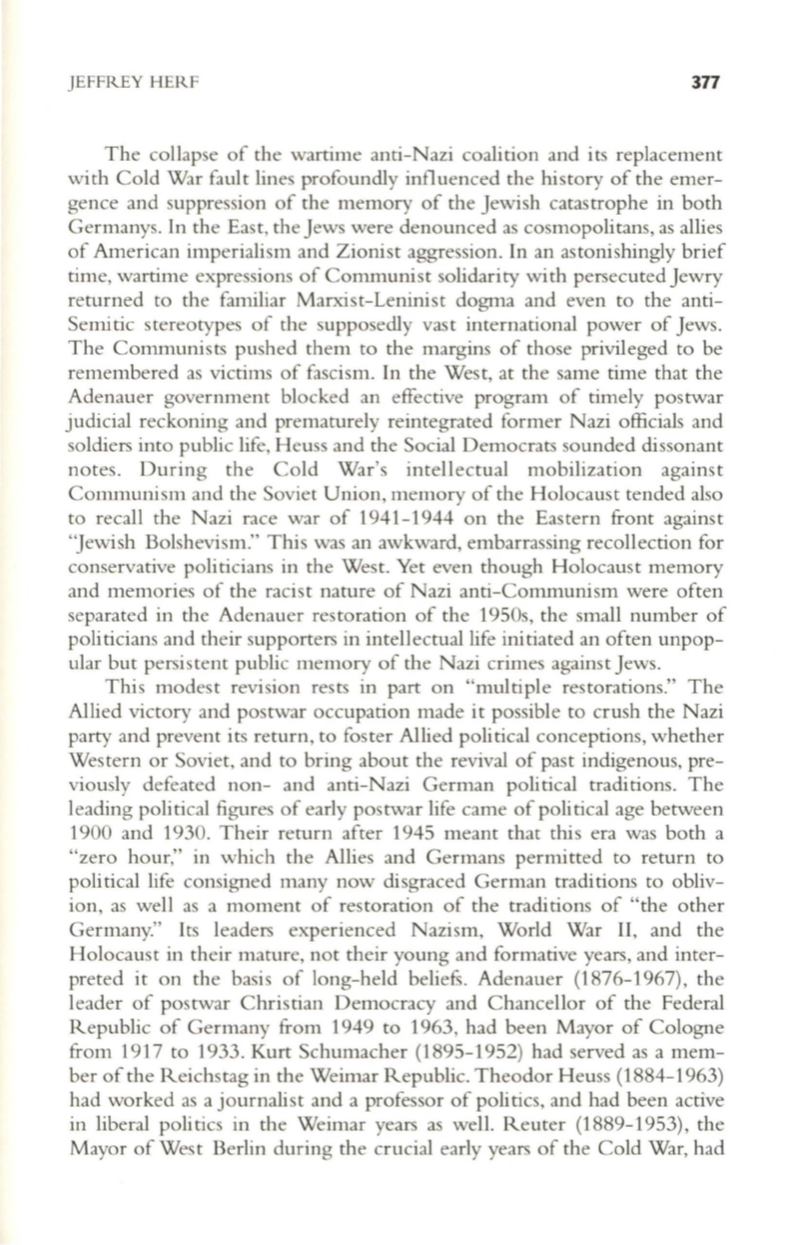
JEFFREY HERF
377
The collapse of the wartime anti-Nazi coalition and its replacement
with Cold War fault lines profoundly influenced the history of the emer–
gence and suppression of the memory of the Jewish catastrophe in both
Germanys. In the East, the Jews were denounced as cosmopolitans, as allies
of American imperialism and Zionist aggression. In an astonishingly brief
time, wartime expressions of Communist solidarity with persecuted Jewry
returned to the familiar Marxist-Leninist dogma and even to the anti–
Semitic stereotypes of the supposedly vast international power of Jews.
The Cornmunists pushed them to the margins of those privileged to be
remembered as victims of fascism. In the West, at the same time that the
Adenauer government blocked an effective program of timely postwar
judicial reckoning and prematurely reintegrated former Nazi officials and
soldiers into public life, Heuss and the Social Democrats sounded dissonant
notes. During the Cold War's intellectual mobilization against
Communism and the Soviet Union, memory of the Holocaust tended also
to recall the Nazi race war of 1941-1944 on the Eastern front against
"Jewish Bolshevism." This was an awkward, embarrassing recollection for
conservative politicians in the West. Yet even though Holocaust memory
and memories of the racist nature of Nazi anti-Communism were often
separated in the Adenauer restoration of the 1950s, the small number of
politicians and their supporters in intellectual life initiated an often unpop–
ular but persistent public memory of the Nazi crimes against Jews.
This modest revision rests in part on "multiple restorations." The
Allied victory and postwar occupation made it possible to crush the Nazi
party and prevent its return, to foster Allied political conceptions, whether
Western or Soviet, and to bring about the revival of past indigenous, pre–
viously defeated non- and anti-Nazi German political traditions. The
leading political figures of early postwar life came of political age between
1900 and 1930. Their return after 1945 meant that this era was both a
"zero hour," in which the Allies and Germans permitted to return to
political life consigned many now disgraced German traditions to obliv–
ion, as well as a moment of restoration of the traditions of "the other
Germany." Its leaders experienced Nazism, World War
II,
and the
Holocaust in their mature, not their young and formative years, and inter–
preted it on the basis of long-held beliefs. Adenauer (1876-1967), the
leader of postwar Christian Democracy and Chancellor of the Federal
Republic of Germany from 1949 to 1963, had been Mayor of Cologne
from 1917 to 1933. Kurt Schumacher (1895-1952) had served as a mem–
ber of the Reichstag in the Weimar Republic. Theodor Heuss (1884-1963)
had worked as a journalist and a professor of politics, and had been active
in liberal politics in the Weimar years as well. Reuter (1889-1953), the
Mayor of West Berlin during the crucial early years of the Cold War, had


